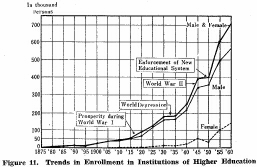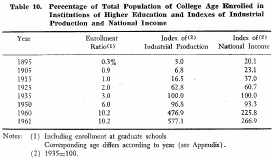| Home > Policy > White Paper, Notice, Announcement > White Paper > JAPAN'S GROWTH AND EDUCATION 1963 > CHAPTER |
||
The enrollment in institutions of higher education remained a1most constant until 1900. In those days secondary education was not so widely spread and institutions of higher education were of limited number. But to these institutions was attached considerable importance front the viewpoint of training national leaders.
About 1900, the enrollment in institutions of higher education began to increase. The growing industry of Japan in the course of the Sino-Japanese and Russo-Japanese wars required the training of persons with specialized educational background. In order to meet such requirements colleges were expanded after 1903:
The expansion of the industrial output after World War I created a greater demand for graduates of institutions of higher education. It also resulted in a considerable increase in the average income, thus enabling more secondary school graduates to continue their education. As a result the number of institutions of higher education and the enrollments therein increased rapidly toward 1930.
During the world depression of 1930, the Japanese economy was setback and enrollments in higher educational institutions remained static for some time. After 1935, however, the number of students increased rapidly in order to meet military requirements for production expansion.
After World War ![]() ,
concurrent with the rapid development of secondary and tertiary industries and
the increase in the demand for university graduates, universities have been opened
widely to the public under the new system. Thus, with the rise in the national
standard of living, the demand for advanced education has increased and the number
of students has increased accordingly. This tendency has been apparent also in
the trend in the percentage of the total population of college age actually entering
institutions of higher education, as shown in Table 10.
,
concurrent with the rapid development of secondary and tertiary industries and
the increase in the demand for university graduates, universities have been opened
widely to the public under the new system. Thus, with the rise in the national
standard of living, the demand for advanced education has increased and the number
of students has increased accordingly. This tendency has been apparent also in
the trend in the percentage of the total population of college age actually entering
institutions of higher education, as shown in Table 10.


The quantitative expansion of higher education and the development of the economy in Japan are shown in Table 10 by comparing the increase
in the percentage of the total population of corresponding age receiving higher education with the increase in the overall industrial production index and national income. The table shows a close relationship between these factors.
| Back to Top | MEXT HOME |